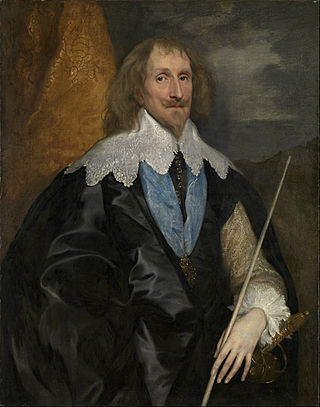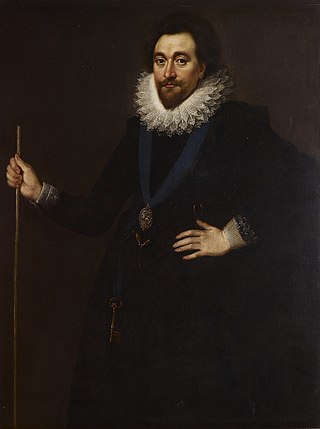Related Research Articles

Edward Montagu, 2nd Earl of Manchester, KG, KB, FRS was an important commander of Parliamentary forces in the First English Civil War, and for a time Oliver Cromwell's superior.

Catherine Carey, after her marriage Catherine Knollys and later known as both Lady Knollys and Dame Catherine Knollys,, was chief Lady of the Bedchamber to Queen Elizabeth I, who was her first cousin.

George Child Villiers, 5th Earl of Jersey, GCH, PC, previously George Villiers and styled Viscount Villiers until 1805, was a British courtier and Conservative politician from the Villiers family.

Philip Herbert, 4th Earl of Pembroke and 1st Earl of Montgomery, was an English courtier, nobleman, and politician active during the reigns of James I and Charles I. He married Susan de Vere, the youngest daughter of Edward de Vere, 17th Earl of Oxford, the Oxfordians' William Shakespeare. Philip and his older brother William were the 'incomparable pair of brethren' to whom the First Folio of Shakespeare's collected works was dedicated in 1623.

William Herbert, 3rd Earl of Pembroke, of Wilton House in Wiltshire, was an English nobleman, politician and courtier. He served as Chancellor of the University of Oxford and together with King James I founded Pembroke College, Oxford. In 1608 he was appointed Warden of the Forest of Dean, Constable of St Briavels Castle, Gloucestershire, and in 1609 Governor of Portsmouth, all of which offices he retained until his death. He served as Lord Chamberlain from 1615 to 1625. In 1623 the First Folio of Shakespeare's plays was dedicated to him and his brother and successor Philip Herbert, 1st Earl of Montgomery.

Henry Norris, 1st Baron Norreys of Rycote in Oxfordshire, was an English politician and diplomat, who belonged to an old Berkshire family, many members of which had held positions at the English court.

William Capell, 3rd Earl of Essex, was an English courtier and diplomat.

Montagu Bertie, 2nd Earl of Lindsey, KG, PC, was an English soldier, courtier, and politician who sat in the House of Commons between 1624 and 1626. He was created Baron Willoughby de Eresby by writ of acceleration in 1640 and inherited the peerage of Earl of Lindsey in 1642. He fought in the Royalist army in the English Civil War.

Dudley Carleton, 1st Viscount Dorchester was an English art collector, diplomat and Secretary of State.
Sir Edward Norreys was a 16th-century Governor of Ostend and English Member of Parliament.

Henry de Vere, 18th Earl of Oxford KB was an English aristocrat, courtier and soldier.

Thomas Carey was a courtier to Charles I and English Member of Parliament.
Bridget Norris, Countess of Berkshire was an English noblewoman, the daughter of Edward de Vere, 17th Earl of Oxford. Bridget was brought up by her maternal grandfather, the powerful statesman William Cecil, 1st Baron Burghley. She was also styled Lady Norris of Rycote and Viscountess Thame. She married Francis Norris, 1st Earl of Berkshire; however, the marriage was not a success, and they separated in 1606.
Elizabeth Wray, 3rd Baroness Norreys, was an English noblewoman. She was the wife of Edward Wray, Groom of the Bedchamber to King James I of England, with whom she eloped in 1622, and incurred the king's displeasure as she was his ward. Elizabeth and her elopement was allegedly the inspiration for Orlando Gibbons Fantazies.

Susan Herbert, Countess of Montgomery, was an English court office holder. She served as lady-in-waiting to the queen consort of England and Scotland, Anne of Denmark. She was the youngest daughter of Elizabethan courtier, and poet Edward de Vere, 17th Earl of Oxford.

Francis Norris, 1st Earl of Berkshire was an English nobleman and courtier.
Christopher Villiers, 1st Earl of Anglesey, known at court as Kit Villiers, was an English courtier, Gentleman of the Bedchamber and later Master of the Robes to King James I. In 1623 he was ennobled as Earl of Anglesey and Baron Villiers of Daventry.
John Villiers was an English courtier from the Villiers family. The eldest son of Sir George Villiers and Mary Beaumont, later Countess of Buckingham, he was the brother of King James I's favourite, George Villiers, 1st Duke of Buckingham.

Frances Coke, Viscountess Purbeck, was the sister-in-law of George Villiers, 1st Duke of Buckingham, and the central figure in a notable sex scandal within the English aristocracy of the early 17th century that was known at the time as "the Lady Purbeck’s business".

Margaret (Mary) Feilding (1613–1638) was a Scottish noblewoman, wife of Duke James Hamilton, and courtier of Queen Consort Henrietta Maria.
References
- 1 2 3 4 5 W R Williams The Parliamentary History of the County of Oxford
- ↑ Kathy Lynn Emerson, A Who's Who of Tudor Women